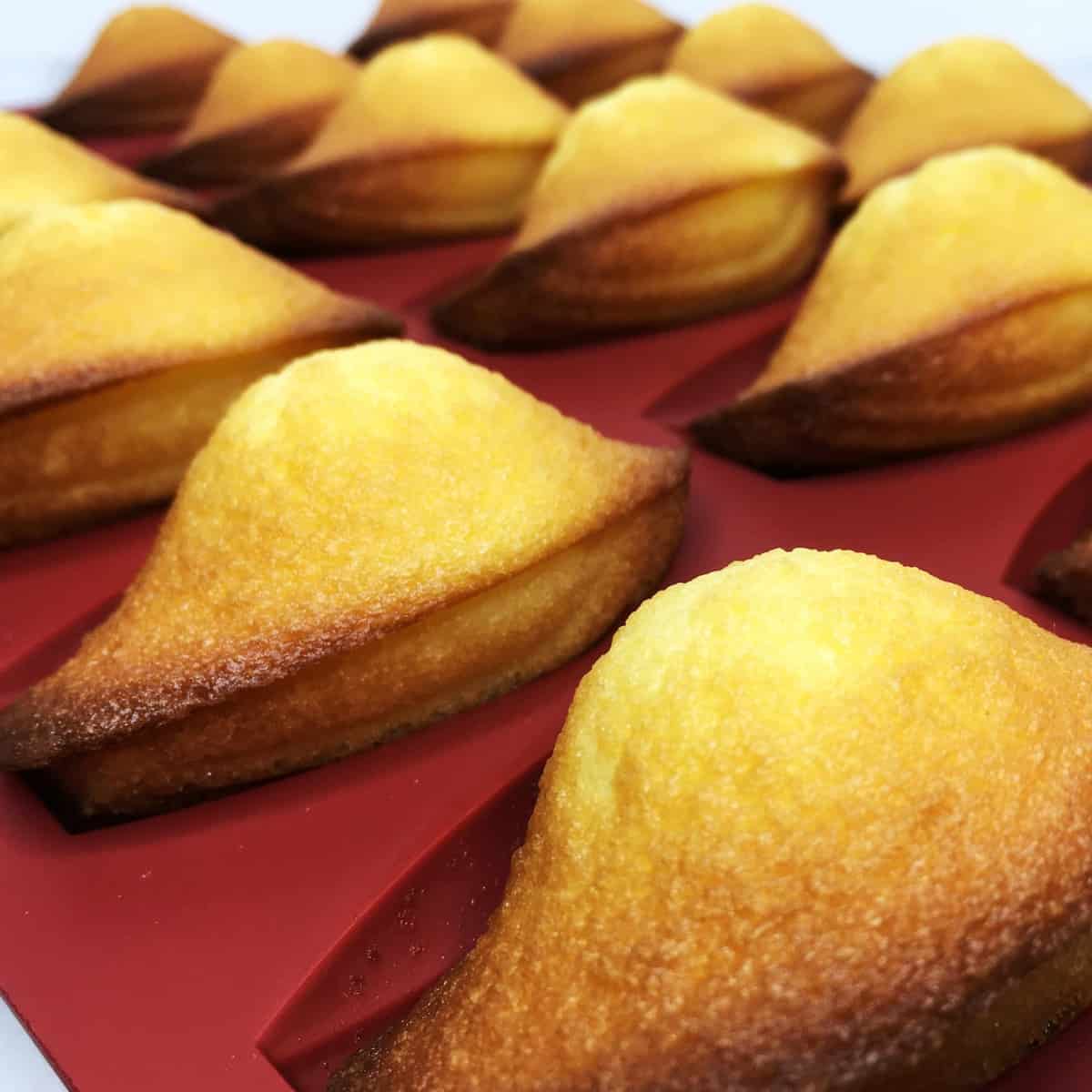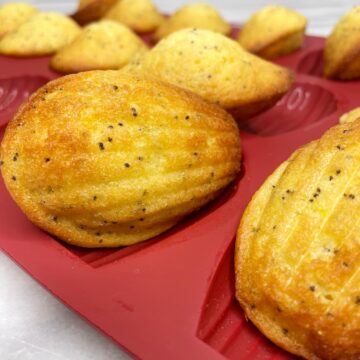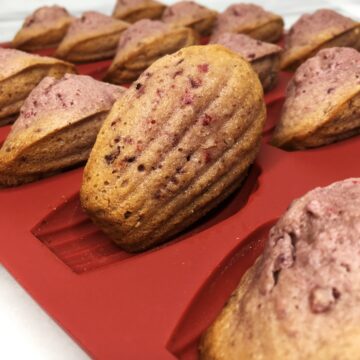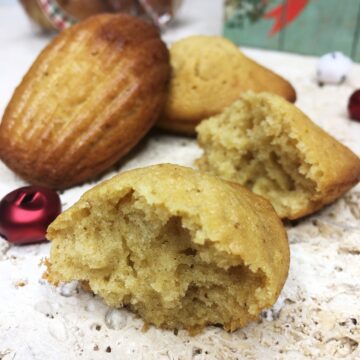This post is a part of my Madeleine series in tribute to this iconic French pastry and all that it means - from its fascinating history, choosing the right pan, all the secrets of authentic madeleine hump, and storage suggestions - you name it!
Discover the French madeleine ingredients that will make your cakes or cookies (still debated) perfect in flavor, taste, texture.

If you are a baker, you know that making madeleines is all about the ingredients.
And if you want to make perfect French madeleines every time, you need to use the right ingredients.
This blog post will tell you everything you need to know about how baking ingredients affect making madeleines.
Jump to:
Ingredients for madeleines
The ingredients of the recipe for real madeleines are pastry basics: flour, butter, sugar, eggs, baking powder...
Here is a guide to all of the principal madeleine ingredients you will find along the bakery aisle of your favorite grocery store.
A great deal can be said about the quality of raw material; what's important here, though?
You should choose high-quality butter that makes up this delicious treat.
Our top-of-the-range madeleine, the Royale, contains 25% butter.
Josette Grojean, from the store À La Cloche Lorraine

Butter
Butter in baking
Butter brings flavor, taste, tenderness, and volume. The flavor given to your baked goods by butter is very distinct; it can’t be mimicked.
French butter madeleines are examples of butter-flavored cakes with real top-quality butter.
Butter plays two crucial roles in the technical aspect of baking:
The first role of butter in baking is to increase friability. For example, butter makes it possible to waterproof the preparation in contact with flour particles and thus increases the friability of dry pasta during cooking.
The second role is that butter also has plasticity, so you can work without changing its texture.
Butter blocks gluten formation due to its structure and dense side.
This is why it is necessary in certain doughs, such as Breton shortbread, for example, and why it must be incorporated at the end into the brioche doughs.
What happens more specifically? The butter coats the flour's proteins and its starch, then essentially controls the water from penetrating the flour and forming gluten.
This is also why when you prepare a shortcrust pastry by hand, you should mix the butter and the flour well to become shortbread.
Butter and madeleines
Butter is an essential madeleine ingredient responsible for these little sponge cakes' flavor, taste, and texture.
According to food historians, the madeleines of Marcel Proust – who “cemented [madeleines] into French hearts and culture” - were quite dry.
Limiting the butter, eggs, and sugar in a recipe is necessary to make these little cakes less moist.
The author of a famous 19th-century cookbook, La Cuisinière de la campagne et de la ville Louis-Eustache Audot, adds butter in a 1:2 weight ratio to flour. As a result, his madeleines indeed have a lighter, drier texture.
Nowadays, most French chefs use the same amount of butter and flour.
Moreover, Philippe Conticini adds a small amount of neutral oil (such as grapeseed oil). It means that modern madeleine pastry is richer, softer, and moister.
Historically, traditional madeleines of Commercy are made with brown butter ("beurre noisette" in French), which is when the butter is heated to get the brown color and the nutty flavor.
Roger Pizey, the author of the book "World Class Cakes 250 Classic Recipes from Boston Cream Pie to Madeleines and Muffins", and Belén from Belula Cusine & More also suggest using brown butter in making French madeleines.
Choosing the butter
It is true that butter makes everything better, especially madeleines.
Nowadays, there are many types of butter to choose from: European, American-made European-style, cultured, artisanal, clarified, flavored, etc.
So which butter to use when you make madeleines? The answer is European, or European-style butter made with higher fat content.
Why? Because butter is not just fat but also a flavoring and taste.
Unsalted butter or salted butter?
Most madeleine recipes call for butter which is unsalted if it is not specified. Still, can you use salted or semi-salted butter?
Let's look at the difference between the three.
Unsalted butter is made after churning the cream without added salt.
Semi-salted butter contains between 0.5 and 3% salt.
For salted butter, the salt rate is higher than 3%. Salted butter is a specialty of Britany where it is called "amann."
Many chefs prefer to make madeleines with semi-salted butter, where a small quantity of salt enhances the flavors and counterbalance the sweetness.
Can you make madeleines with salted butter? Technically, yes, and there are French recipes for salted butter madeleines.
Melted butter or softened butter?
Another debate that agitates all madeleine lovers is about the state of butter: should it be softened or melted?
The quick answer is it depends. Melted butter gives a dense texture to your baked madeleines, while the softened butter delivers a more airy and lighter consistency and softer madeleines.
Want to be the smartest? Mix the two!
Eggs
Eggs in baking
An egg comprises two parts: the egg white and the egg yolk. The first mainly contains water and very little protein, while the yolk contains fat and protein.
What role of eggs in baking?
The egg whites trap the air while whipping it. And they keep this air while baking.
This is the topic of many cakes, for example, Sponge Cake, which is soft thanks to the air. Egg whites also give structure, using sugar as in meringues.
Egg yolks give color and flavor and work as a binder, for example, in custards. Yolks also trap the air, but less than the egg whites.
The egg whites coagulate from 143 degrees F/62 degrees C, forming a rigid, elastic, and translucent gel, while the egg yolks coagulate around 154 degrees F/68 degrees C and provide the binder.
The lipid contained in the egg yolks allows to fix the aromas and plays the coloring action under the effect of heat due to the egg pigments.
Room temperature or chilled eggs?
Using eggs at room temperature is essential in madeleine baking. When all the baking ingredients are at the same temperature, it is easier for them to come together.
Make sure to bring eggs to the counter to get them to room temperature.
But why would you want to wait? One of the most common readers' questions is, "How do I quickly bring my eggs up to room temperature so they a ready for baking?"
Well, there is a little trick. All it takes are a few minutes in a bowl filled with warm water. Then, place the eggs with shells for 5 minutes: your eggs will be ready to use.
Sugar
Sugar in baking
Sugar is a flavor enhancer, thanks to its sweetening power. Due to its solubility in water and under heat, sugar dissolves quickly in the preparations.
Sugar brings a sweet taste to your goods but not only. It gives smoothness when it is blanched with egg yolks, crispiness in shortbread, and it is used to soften acidulous flavors.
It increases the coagulation temperature of the eggs. And this explains why it is possible to cook pastry cream or custard at a higher temperature.
Sugar is also used to color in cooking (just think of caramel).
It gives structure to your baked goods and traps the air as in meringue, for example, or soft cakes.
Finally, it lowers the freezing temperature of the water. This is why it is essential in ice creams and sorbets to prevent them from becoming blocks of marble.
Sugar and madeleines
Sugar is another madeleines recipe ingredient. But what type of sugar should you use?
It is again: it depends. While Louis-Eustache Audot, Roger Pizey, Pierre Hermé use caster sugar, Sebastien Rouxel goes for a mixture of caster and brown sugar.
Another French chef Philippe Conticini often replaces caster sugar with light brown muscovado sugar that brings a toffee-like taste.
You can experiment with the different types of sugar (granulated sugar, golden brown, muscovado, or demerara sugar) to give your madeleines an interesting flavor and color.
But keep in mind that they will taste slightly different depending on what you choose.

Flour
Flour in baking
Flour is an almost vital ingredient in baking. It comes from the grinding of wheat grains and contains starch grains.
The difference between the flours mostly comes from the extraction rate.
Flour gives texture (just think of pasta) because the starch contains "gels" when heated with water, which traps the air contained and allows the cake's texture to be retained even when it has cooled.
Flour plays an essential role in the elasticity of your cake batters or bread doughs, thanks to the gluten.
The more you work the bread dough, the more the flour forms gluten, and the more elastic the dough. This is why a broken dough is little worked, unlike brioche.
Does the flour give a flavor? Yes, because the longer you bake the dough or batter, the more the flour will be roasted and the more flavor it will provide.
A nicely golden pastry will have a more pungent scent than a completely white pastry. Also, the use of other flours will bring a different flavor.
Flour also gives density and structure. The more flour you add to a dough, the more packed it becomes. Too much flour results in a dry, stuffy pastry.
Flour in madeleine making
The authentic French madeleine recipe calls for flour T55, which is medium in protein content (9.4%) and contains 0.55% mineral content.
These characteristics assure the perfect fermentation and rising of the dough.
French T55 flour is equivalent to American all-purpose flour, type 0 Italian flour, and Euro 550 flour.
Should you sift the flour to make madeleines? Yes, you should sift it to make sure that there are no lumps.
More importantly, sifting flour with baking powder helps combine them and mix evenly with other ingredients.
Milk
Milk added to the batter or dough moistens them and gives them a little more softness.
The most obvious example is yeast dough: if you add milk instead of water in classic bread dough, you will get a much softer crumb and crust reminiscent of buns.
The fat in the milk drives it possible to fix the aromas, that is to say, that the scents will develop further.
Not all, but some madeleine recipes call for milk. French chef Philippe Conticini uses semi-skimmed milk since it contains 97% water, bringing additional moisture to his sweet creations.
Rising agent
Leavening agents make the dough rise and lighten it. The baking powder is a crucial element of the classic madeleine recipe because it acts during baking to form this lovely hump on top of the madeleines.
How much baking powder should you use?
Most chefs, such as chef Philippe, Philippe Contichini, Cédric Grolet, add the baking powder that is 1/20 of the amount of flour used in a recipe.
David Lebovitz uses a bit less and even recommends using baking powder optionally.
Be aware that baking powder can be kept for a very long time, but not forever.
Since it is sensitive to moisture and humidity, both opened and unopened have a shelf life of between 6 months to one year.
To avoid flat madeleines, test your baking powder is still active. To do so, spoon ½ teaspoon in a glass and pour ¼ cup/60 ml of boiling water.
It should bubble up right away. If it does, the baking powder is good to use. If it doesn’t, discard it and purchase a new tin.
For madeleines to grow well in the oven, it is crucial that baking powder not be activated too early before baking.
This phenomenon occurs when hot melted butter is poured into preparation. The heat activates the powder, which means your madeleines will no longer swell while baking.
So wait until the melted butter cools down to 120 °F/50 °C, then add to the batter mixture.
Other sweeteners
Honey is often added to madeleines. Chefs Sebastien Rouxel and Philippe Conticini claim that honey increases the moisture and flavor of the madeleines.
It also brings just the right amount of sugar and a pleasant aftertaste, the one that makes you want to bite into a madeleine again and again.
Flavors
Classic French madeleines are made with citrusy additions which accentuate the buttery taste. A hint of lemon is essential in madeleine baking.
Pierre Hermé, for example, uses lemon zest, Roger Pizey adds orange zest, and Audot uses a combination of orange flower water and lemon zest.
Philippe Conticini varies the taste of his perfect madeleines by using the zest of fingered citron or the Buddha's Hand, lime, or lemon. Sebastien Rouxel suggests adding 1 to 2 drops of lemon oil.
These little cakes can also be glazed with sugar and lemon glaze.
How to make madeleines without lemon? The answer is simple; just use vanilla extract or seeds of vanilla beans.
Salt
A tiny amount of salt is used even in baking: it works as a flavor enhancer. It also helps to enhance pastries that are a little too sweet.
Moreover, it helps in preservation. Finally, it allows the homogenization of the coloring of the dough.
Some madeleine recipes call for salt; some use semi-salted butter, others don't require salt at all.
Conclusion
Nothing is simpler to make the best French madeleines using pastry basics - baking ingredients most people have at home.
The key is top-quality butter, fresh eggs, fresh baking powder, and the zest of organic, non-treated lemon.
Madeleine recipes
Madeleines are classically elegant and delicious French cakes, but it's not always easy to know how they are made.
I hope this article will help you realize your next batches.
If you are looking for the best French madeleines with the authentic hump, grab all an error-free recipe below.
Also, enjoy the twisted recipes on traditional madeleines. Happy baking!











Comments
No Comments